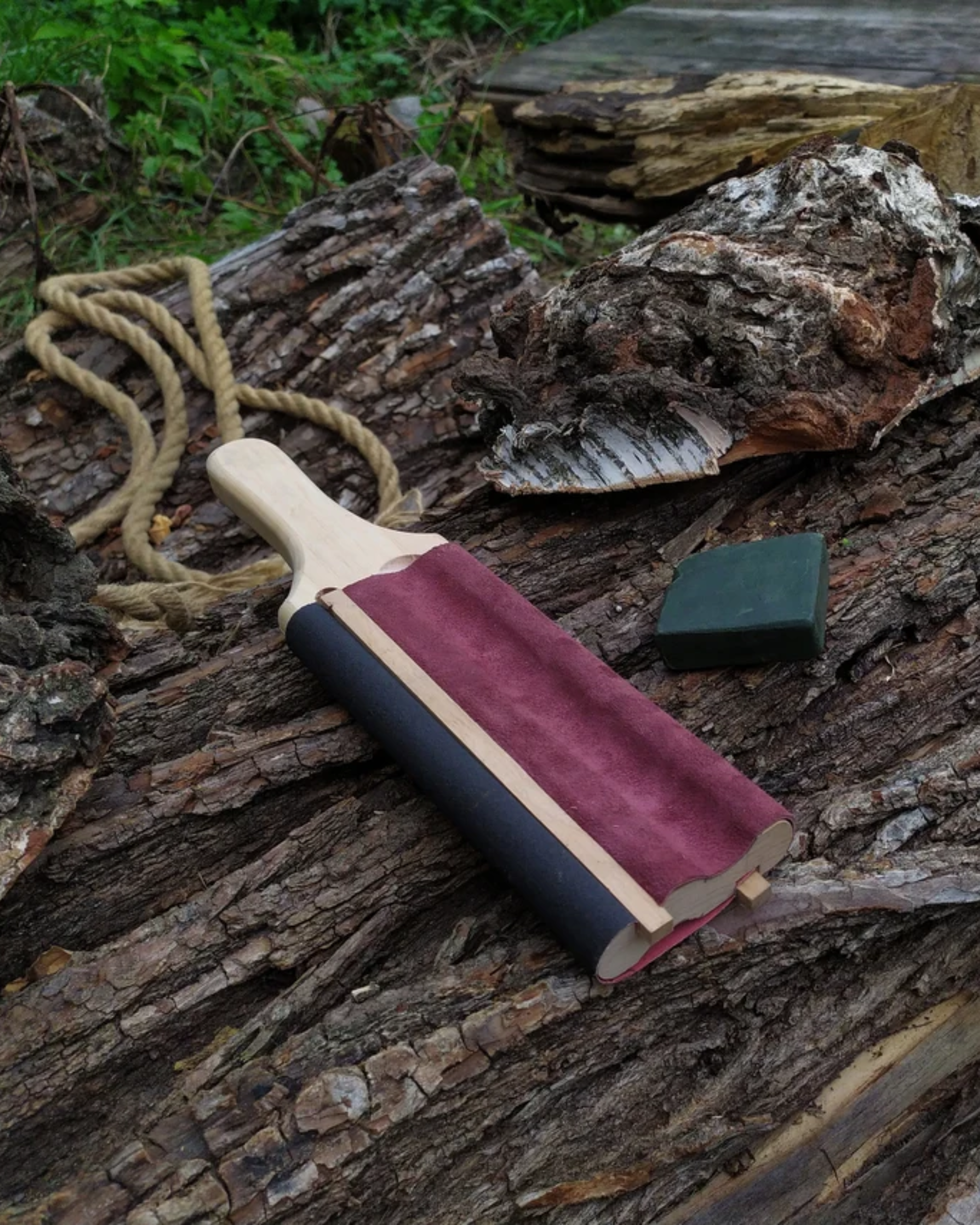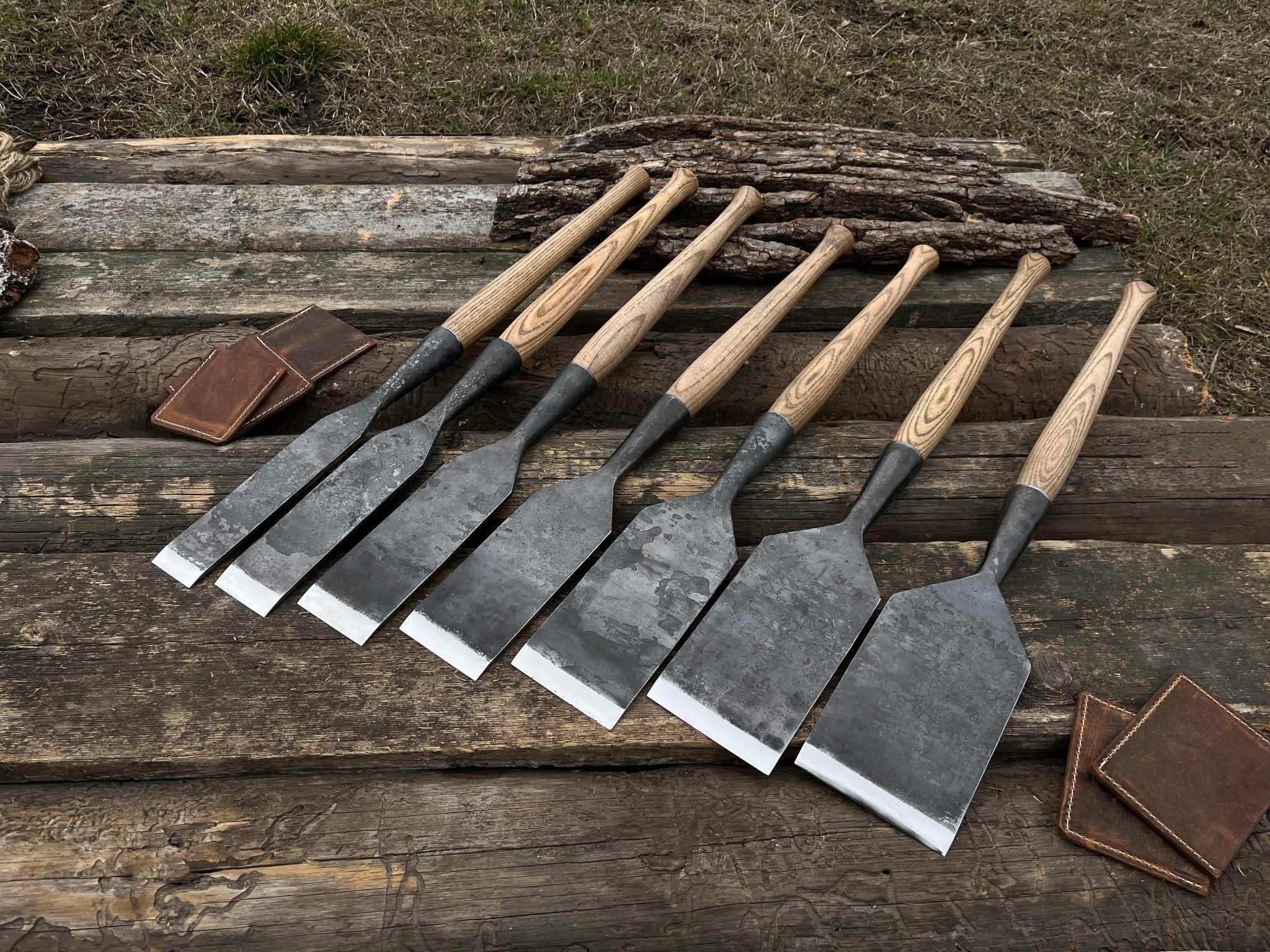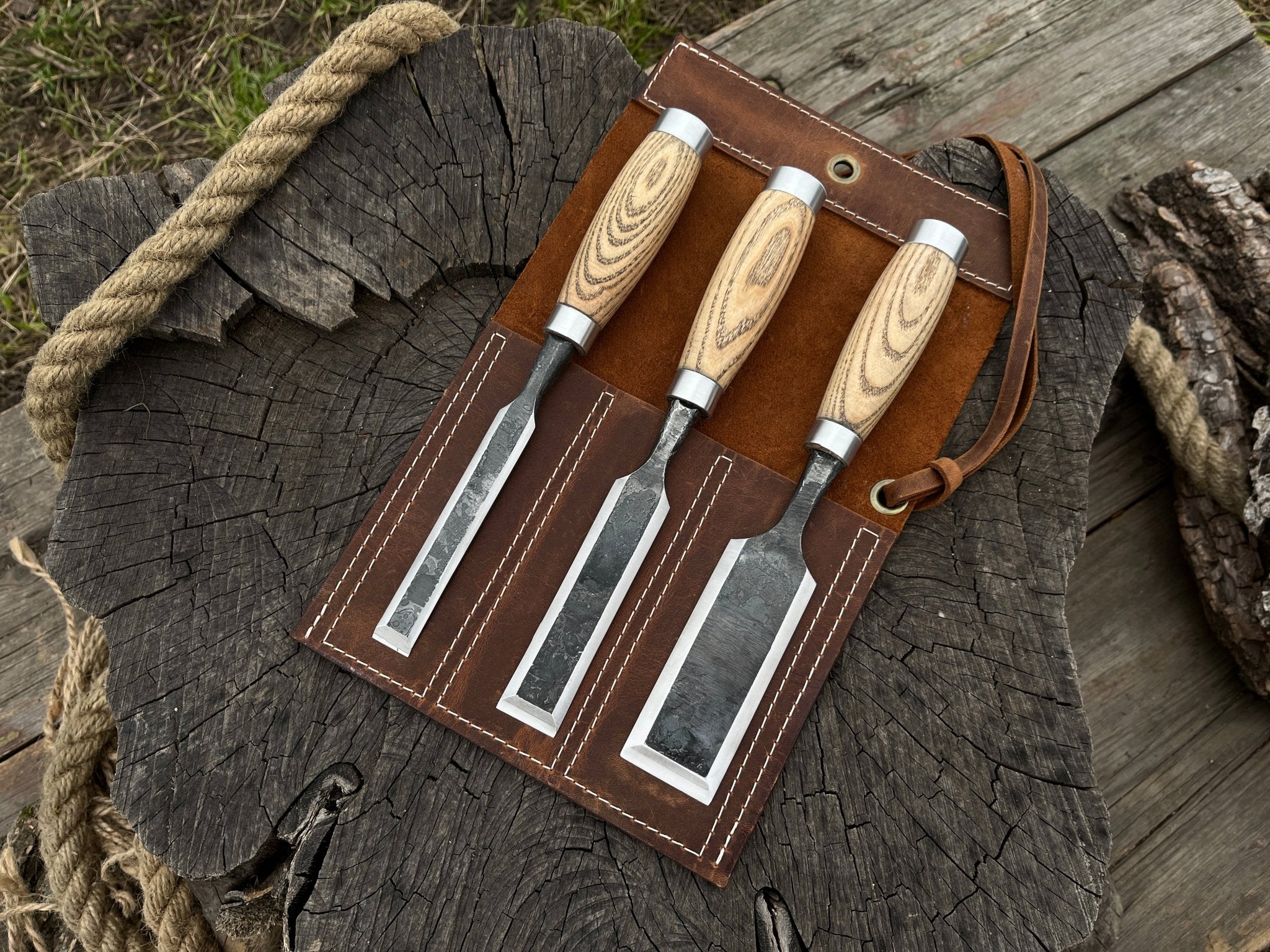2-Piece Hand-Forged Spoon Carving Tool Set WS2
Hand-Forged Stock Knife with Attachments
3-Piece Hand-Forged Straight Drawknife Set
3-Piece Inshave (Half-Rounded Drawknife) Set, ⌀ 9, 13, 16.5 cm (3.5, 5.1, 6.5 inch)
4-Piece Hand-Forged Rounded Carpenters Timber Chisel Set
7-Piece Hand-Forged Long Timber Framing Chisel Set

3-Piece Hand-Forged Straight Rounded Chisel Set
3-Piece Hand-Forged Wood Carving Chisel Set
6-Piece Hand-Forged Straight Rounded Chisel Set
3-Piece Hand-Forged Wood Carving Chisel Set
6-Piece Hand-Forged Wood Carving Chisel Set
Why the Right Tool Set Matters
Wood carving kits are collections of tools used for woodcarving. They can include various knives, gouges, and chisels. Most beginners or hobbyists do not need an extensive woodcarving set. For small projects like whittling, a single wood carving knife is often sufficient.
Those who want to enhance their craftsmanship skills may need a small set of woodcraft tools with a roughing knife, a regular carving knife, a detail knife, and a scoop knife for tasks like spoon carving. This kit can handle 99% of carving needs and is convenient for travel.
The basic woodworking tools can accomplish most of the tasks, while additional tools like a detailed knife or a leather strop for maintaining the knife’s edge are usually nice-to-haves.
Broadly speaking, carving sets can cater to the needs of woodworkers of any level and skill set, from artists who use wood as a medium for creating detailed artwork to professional carvers who require specific tools for advanced woodworking, to DIY enthusiasts creating wooden items like toys or pieces of furniture as a pastime.
For those unsure about committing to woodcarving, there are carving sets for beginners that usually include a few different knives and gouges, providing a good starting point.
Types of Tools in a Wood Carving Set
The tools in a whittling kit should evolve as a woodcarver's carving techniques improve with practice. If set wood carving tools were classified by skill level, the breakdown would be as follows:
Beginner Carver Toolset
A basic woodcarving set should contain foundational tools to start carving simple projects, such as simple utensils or figurines:
- Carving Knife (Sloyd Knife): A multi-purpose knife for general carving tasks.
- Hook Knife: Designed for carving concave shapes, such as spoons and bowls.
- Chisel Set (Straight Chisel): Used for basic shaping and smoothing surfaces.
- V-Gouge: Creates simple grooves and lines, allowing woodworking precision when adding fine details to carvings.
- Sharpening Stone: Crucial for keeping all tools sharp.
- Strop with Polishing Compound: Used to refine edges after sharpening.
Medium Level Carver Toolset
With some carving experience, a woodcarving set can be expanded. At this skill level, more specialized tools may be needed:
- Detail Knife: Designed for detailed carving, featuring small, pointed blades that can be applied in relief or chip carving, as well as fine detailing.
- Skew Chisel: Particularly useful in woodturning, creating angled cuts and transitions between different shapes on a spindle, forming beads, and raised shapes.
- Round Chisel: Creates rounded grooves and channels. Suited for hollowing out areas and adding rounded details and textures.
- U-Gouge: Used for creating deep concave shapes and removing large amounts of material quickly.
- Mallet: Used together with chisels or gouges for more controlled, deeper cuts.
- Specialty Sharpening Stones: Customized to different blade types and materials.
Experienced Level Carver Toolset
When practice turns into quality and high-level skill, it’s time to take on larger projects like furniture carving or creating large wooden installations. This is when woodcarvers choose highly specialized woodcraft tools to tackle advanced techniques and sophisticated designs:
- Micro Gouges and Chisels: Widely used in detailed carving for enhancing the overall detail, reaching tight areas, adding precise details.
- Carving Axe: Ideal for rough shaping and removing large chunks of wood.
- V-Parting Tool: Creates deep, sharp lines and helps with undercuts, adding depth and dimension.
- Carving Rasps: Used for shaping and smoothing wood.
- Power Carving Tools: Used to speed up the process instead of traditional woodworking tools. They may be efficient for quick material removal, adding detailed patterns, or working with materials other than wood (e.g., metal and epoxies).
In addition to standard wood carving kits, several crafting tools may aid in the preparation and successful completion of any project for carvers of any skill level:
- Carving Bench: A stable workbench provides a secure surface and may come with built-in storage for wood carving kits, keeping everything within easy reach. Some advanced benches have adjustable heights or angles, allowing work on different types of projects in a comfortable setting.
- Clamping Systems: Clamps hold a workpiece securely in place, preventing movement and reducing the risk of accidental slipping of hand tools for wood carving. Clamping systems can adjust to various shapes and sizes of wood.
- Marking and Measuring Tools: Carving kit wood tools like calipers, rulers, and marking knives help make controllable and precise cuts, ensuring consistency across different parts of a project.
- Drawknives: These traditional tools can quickly remove large chunks of wood, preparing the workpiece for rough shaping and finer carving.
- Finishing Supplies (Wood Oils, Beeswax, Varnish/Lacquer): Wood oils (Tung or Linseed) enhance the wood grain; beeswax polishes and seals wood surfaces; varnish/lacquer offers durable protection.
How to Choose the Right Wood Carving Tool Set
Consideration of Skill Level and Set
The choice of hand tools for wood carving depends on skill level and the type of carving a craftsman plans to do. Common carving types include whittling, in-the-round carving, relief carving, and chip carving, each with unique techniques and results.
- Whittling is a wood carving art of shaping wood with a knife, leaving knife marks that create a rough, hand-honed texture. It is the simplest type of woodcarving that can be done with a minimal wood carving tools set. A sloyd knife is the essential tool, though a detailed knife may help with more sophisticated patterns. Adding a hook knife to the wood carving tools set is optional but can be beneficial when carving items like bowls and spoons.
- Relief carving creates three-dimensional wood sculpting designs on a flat surface. Essential wood carving sets include chisels for straight cuts, gouges for curves and hollows, V-tools for sharp lines, and general purpose knives.
- In-the-round carving involves shaping wood into complete, standalone figures. Essential tools include whittling knives for detailed sculpting, chisels for straight cuts and removing bigger chunks of wood, gouges for hollowing out, V-tools for sharp lines, and a mallet for guiding chisels and gouges with controlled force.
- Chip carving decorates flat surfaces with geometric/free-form patterns. A few essential carving set wood tools would be chip carving knives, stab knives for deeper cuts, measuring tools like pencils, erasers, T-square rulers.
Choosing the Right Blade Material
Next comes the question of wood carving sets quality and this is when blade material should be considered, as it impacts the tool’s longevity and efficiency.
- High Carbon Steel: Most preferred for carving knives like sloyd and detailed knives, gouges, chisels.
Key Features: Holds a sharper edge, requires less frequent tool sharpening, and handles tough tasks but is prone to rust and needs regular maintenance.
- Stainless Steel: Can be a better choice for work in humid environments, usually preferred in chip carving knives and detailed knives.
Key Features: Corrosion resistant, require less care in contrast to carbon steel, but it dulls faster and is harder to sharpen.
- Tool Steel: Withstands heavy-duty tasks; it is preferred in heavy-duty chisels, gouges, and carving axes.
Key Features: Wear resistant and durable, holds a sharp edge but requires regular care.
- Laminated Steel: Usually used in specialized tools.
Key Features: Holds a sharp edge, demonstrates good durability due to protection of its hardened brittle inner layer. Requires special maintenance and is more expensive.
Ergonomics and Comfort in Use
Carving often requires long hours, so ergonomics of wood carving sets is highly important to avoid hand strain.
Key points to consider:
- Grip strength: Poorly designed handles can lead to excessive grip strength, causing strain in the hand; a good handle design minimizes effort and ensures a steady grip.
- Handle size and shape: Increasing the size of the handle and adding facets to it can significantly improve grip and comfort.
- Control and precision: The tool design should facilitate different grips to enhance overall cutting control.
- Personalization: Ergonomics vary by individual, so finding the best tool takes time.
Set Composition: What to Look For
A good wood carving tools set balances quality, variety, and usability. A few more key components to search for in wood carving kits include:
- Quality materials: Look for high-quality steel and ergonomic handles for better grip and longevity.
- Sharpened out of the box: Wood carving tools should come sharp or be easily sharpened.
- Storage solutions: A well-organized storage roll makes transportation of the wood carving set a lot easier.
- User guides: Some kits include instructional materials or suggest tutorials to help carvers learn best practices.
Conclusion and Final Tips
Well-selected wood carving sets contribute to skill development and allow for future enhancements by expanding the existing collection. Beginners can start with a basic set, while seasoned carvers may opt for specialized woodcarving kits for intricate designs.
In addition to selecting tools, consider creating a safe, well-lit workspace with a workbench and clamps for secure carving.
Final Tips:
- Start with simple carving techniques and tool sets to build confidence.
- Join a community to learn from others and exchange experiences. Engaging with fellow enthusiasts provides valuable insights, inspiration, and opportunities for skill sharing.











